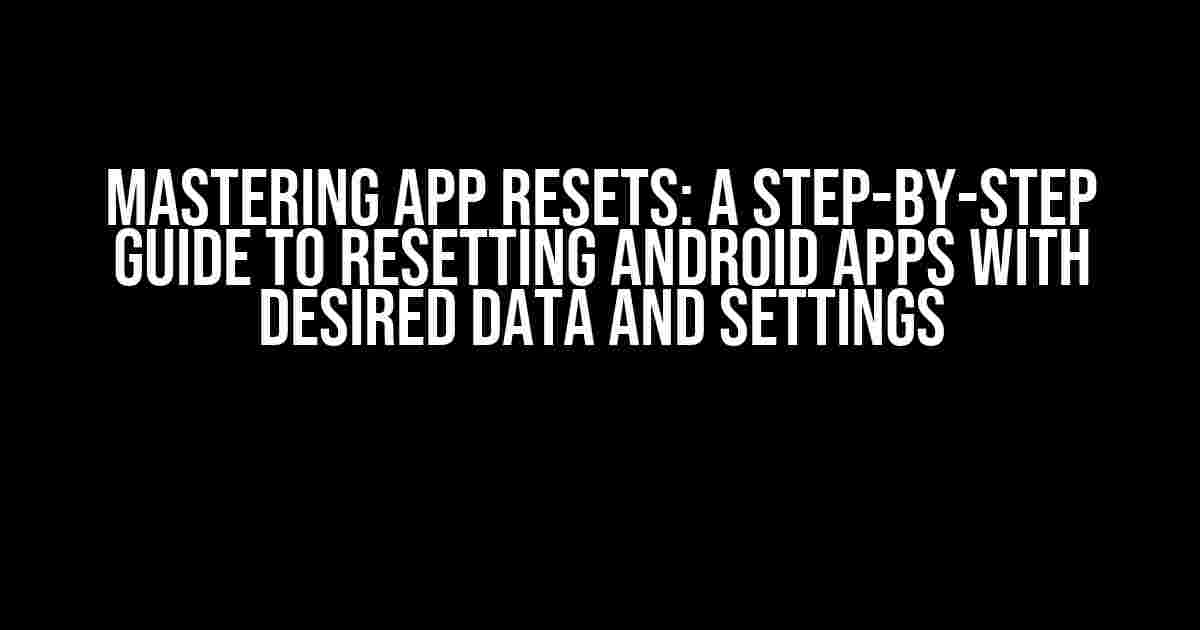Are you tired of manually configuring your Android app every time you want to test a specific scenario or troubleshoot an issue? Do you wish there was a way to automatically reset your app to a state with a defined set of data and settings? Look no further! In this article, we’ll dive into the world of app resets and explore the various methods to achieve this feat.
Why Reset an Android App?
Resetting an Android app can be useful in various scenarios:
- Testing and debugging: Resetting an app to a known state helps developers test specific features or reproduce issues efficiently.
- Content creation: App resets can aid content creators in generating specific app states for tutorials, reviews, or promotional materials.
- Troubleshooting: When an app misbehaves, resetting it to a clean state can help identify and fix the issue.
- Research and analysis: Researchers can use app resets to collect data on user behavior or analyze app performance in controlled environments.
Method 1: Clearing App Data via Android Settings
This method is the most straightforward way to reset an Android app. Here’s how to do it:
- Go to your Android device’s
Settingsapp. - Scroll down and select
AppsorApplication Manager. - Find the app you want to reset and select it.
- Tap the
Storageoption. - Tap the
Clear DataandClear Cachebuttons.
This method will remove all app data, including settings, login information, and stored files. However, it’s essential to note that this method does not guarantee a complete reset, as some data might be stored externally or in non-standard locations.
Method 2: Using Android’s Built-in Reset Option
Android 10 (Q) and later versions provide a built-in reset option for apps. Here’s how to use it:
- Go to your Android device’s
Settingsapp. - Scroll down and select
AppsorApplication Manager. - Find the app you want to reset and select it.
- Tap the
⋯icon (three vertical dots) in the top-right corner. - Tap
Reset app preferences.
This method will reset the app’s settings to their default values, but it won’t remove stored data. If you want to remove data as well, you’ll need to use Method 1 in conjunction with this method.
Method 3: Using Android Debug Bridge (ADB)
ADB is a powerful tool that allows you to interact with your Android device from your computer. Here’s how to use ADB to reset an app:
- Enable
Developer optionsandUSB debuggingon your Android device. - Connect your device to your computer using a USB cable.
- Open a terminal or command prompt on your computer.
- Navigate to the platform-tools directory of your Android SDK.
- Run the command
adb shell pm clear, replacingwith the app’s package name (e.g., com.example.app).
This method will clear the app’s data and cache, effectively resetting it to a clean state. However, it requires some technical knowledge and a computer with ADB installed.
Method 4: Using an Automated Testing Framework
If you’re a developer or need to perform repeated app resets for testing or research purposes, you can use an automated testing framework like Appium or UiAutomator.
These frameworks allow you to create scripts that can automate app interactions, including resetting the app to a specific state. Here’s an example using Appium:
import os
from appium import webdriver
# Set up the Appium driver
driver = webdriver.Remote('http://localhost:4723/wd/hub', desired_capabilities={'platformName': 'Android', 'deviceName': 'YOUR_DEVICE_NAME'})
# Clear the app's data
os.system('adb shell pm clear com.example.app')
# Start the app
driver.start_activity('com.example.app', '.MainActivity')
This script uses the Appium Python client to clear the app’s data using ADB and then starts the app’s main activity. You can modify the script to perform additional actions or resetting steps as needed.
Method 5: Creating a Custom Reset Mechanism
If you’re developing an app and want to provide a reset mechanism specifically tailored to your app’s needs, you can create a custom solution.
One approach is to use a combination of shared preferences, internal storage, or a SQLite database to store your app’s settings and data. When the user wants to reset the app, you can simply clear these storage mechanisms and restore the default values.
Here’s an example using shared preferences in Kotlin:
import android.content.SharedPreferences
class ResetManager(private val context: Context) {
fun resetApp() {
val prefs = context.getSharedPreferences("app_prefs", Context.MODE_PRIVATE)
prefs.edit().clear().apply()
// Restore default values
prefs.edit().putBoolean("setting1", true).apply()
prefs.edit().putString("setting2", "default_value").apply()
}
}
This code creates a `ResetManager` class that clears the app’s shared preferences and restores default values when the `resetApp()` method is called.
Conclusion
Resetting an Android app to a state with a defined set of data and settings can be a complex task, but with the right tools and techniques, it’s definitely achievable. In this article, we’ve explored five methods to reset an Android app, each with its own strengths and limitations.
Whether you’re a developer, tester, or researcher, we hope this guide has provided you with the knowledge and inspiration to master app resets and streamline your workflow.
| Method | Description | Advantages | Disadvantages |
|---|---|---|---|
| Clearing App Data via Android Settings | Clears app data and cache using Android settings | Easy to perform, doesn’t require technical knowledge | Doesn’t guarantee a complete reset, may not remove all data |
| Using Android’s Built-in Reset Option | Resets app settings to default values using Android 10’s built-in option | Easy to perform, doesn’t require technical knowledge | Only available on Android 10 and later, doesn’t remove stored data |
| Using Android Debug Bridge (ADB) | Clears app data and cache using ADB commands | Allows for scriptable automation, can be used for testing | Requires technical knowledge, may not be suitable for non-developers |
| Using an Automated Testing Framework | Automates app interactions and resetting using a testing framework | Allows for complex automation scenarios, can be used for testing and research | Requires technical knowledge, may require significant setup and maintenance |
| Creating a Custom Reset Mechanism | Creates a custom solution for resetting the app using internal storage or databases | Allows for fine-grained control over the reset process, can be tailored to the app’s specific needs | Requires technical knowledge, may require significant development and maintenance |
We hope this comprehensive guide has helped you understand the various methods for resetting an Android app with a defined set of data and settings. Happy resetting!
Frequently Asked Question
Get answers to the most common questions about resetting an Android app to a state with a defined set of app data and settings automatically.
Can I reset an Android app to a specific state without manually deleting data and settings?
Yes, you can! By using a specialized reset mechanism, you can restore an Android app to a pre-defined state with specific data and settings. This can be achieved by creating a custom reset feature within the app or using third-party tools that support app resetting.
What are some common scenarios where resetting an Android app to a defined state is useful?
Resetting an Android app to a defined state can be useful in scenarios such as testing, debugging, or preparing the app for demo or presentation purposes. It can also be helpful when you want to revert to a previous version of the app or restore a specific configuration.
Can I automate the app resetting process using scripts or APIs?
Yes, it is possible to automate the app resetting process using scripts or APIs. You can use Android’s built-in mechanisms, such as the Android Debug Bridge (ADB), to programmatically reset the app to a defined state. Additionally, some third-party tools and libraries provide APIs for resetting apps automatically.
How do I ensure that the app data and settings are properly reset to the desired state?
To ensure that the app data and settings are properly reset, you should carefully define the desired state and test the resetting process thoroughly. You can also use logging and debugging tools to verify that the app has been reset correctly.
Are there any security considerations I should be aware of when resetting an Android app to a defined state?
Yes, it’s essential to consider security implications when resetting an Android app. You should ensure that sensitive data, such as user credentials or payment information, is properly cleared and not exposed during the resetting process. Additionally, be cautious when using automation tools or scripts to avoid introducing security vulnerabilities.


